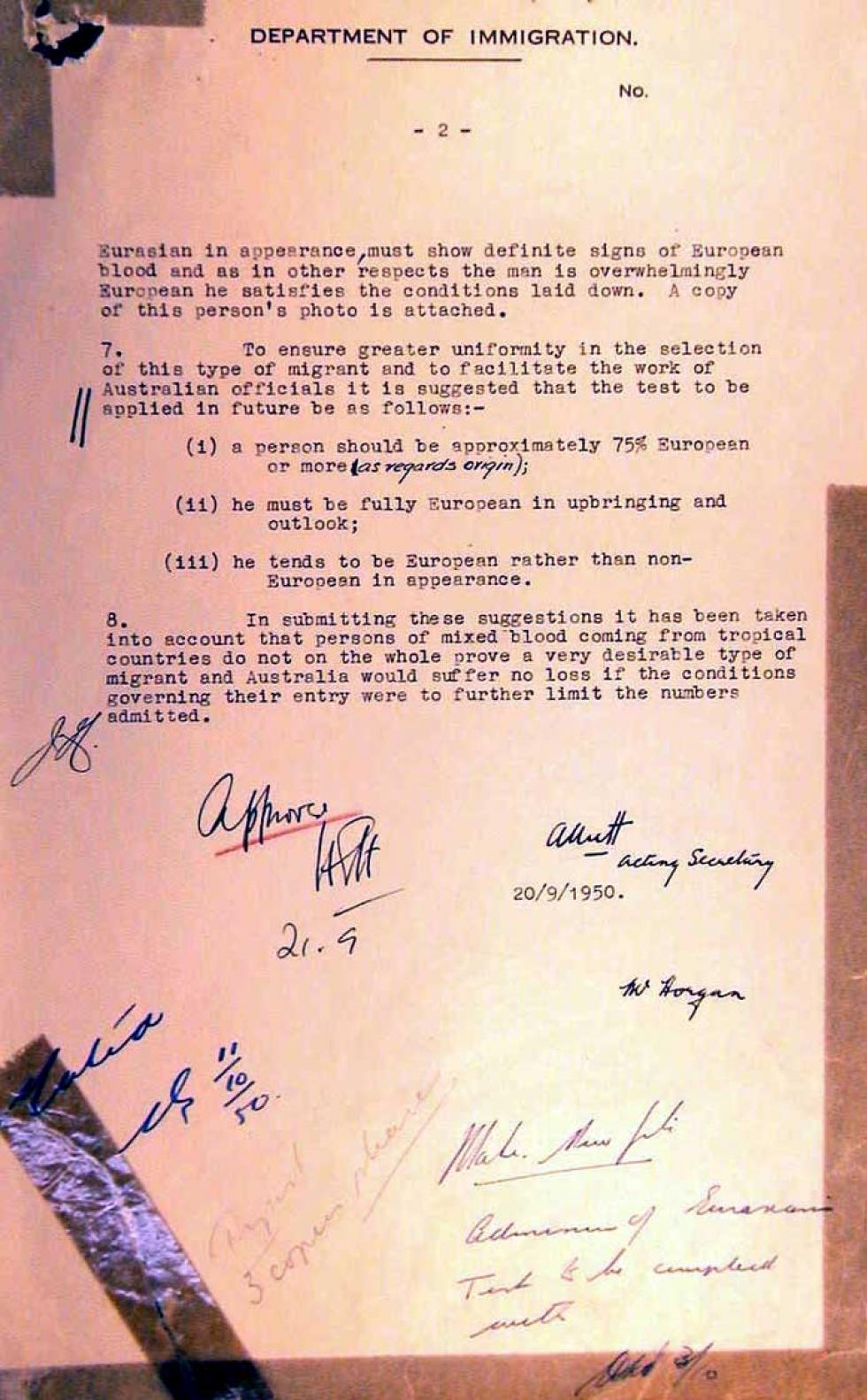

Aboriginal and Torres Strait Islander people should be aware that the National Archives' website and collection contain the names, images and voices of people who have died.
Some records include terms and views that are not appropriate today. They reflect the period in which they were created and are not the views of the National Archives.



[Page 1.]
[Letterhead:] DEPARTMENT OF IMMIGRATION.
MK.
[Stamped: 'RESTRICTED IMMIGRATION', '10 OCT 1950', 'RECEIVED'.]
[Stamped: 'DEPT. OF IMMIGRATION', 'CANBERRA', with handwritten reference number '50/2/8346'.]
[Underlined heading:] CONDITIONS GOVERNING THE ADMISSION OF PERSONS OF MIXED BLOOD TO AUSTRALIA.
[Paragraph highlighted with a vertical line in the margin.] The basic principle of Australia's traditional immigration policy is that with a few exceptional cases non-Europeans shall not be permitted to settle here permanently. The term "non-European" has been interpreted as meaning a person who possesses [the word 'not' is inserted in pen] less than 50% coloured blood or in other words is [‘less than’ crossed out, replaced with 'at least'] at least half-caste. [End of line in margin.]
2. Up till recent years the number of Eurasians who sought to come here were comparatively few and their entry caused no comment. The test then applied as to whether a person was eligible for admission was the production of evidence from which it could be accepted that he was at least 51% of European origin.
3. The fact that large numbers of Dutch and American soldiers, who were partly coloured, served in Australia during the war and that political changes occurred in Asian countries which made the position of Eurasians living there less secure than formerly, led to a very big increase of applications by partly coloured persons for permission to settle in Australia.
4. For the guidance of Australian officials who were required to determine such applications and to avoid criticism that our immigration policy was being broken down it was decided that eligibility for admission should depend on the following factors:
(i) a person must be preponderantly of European origin;
(ii) he should have a European outlook; and
(iii) he should be of European appearance.
5. This test greatly reduced the number of Eurasians who were regarded as being eligible for admission. Some adverse criticism did, however, arise because some persons were admitted who showed pronounced signs of colour, and it became apparent that there was a diversity of opinion amongst officers as to how the test is to be applied, for example one officer may take the view if a person is decidedly of European origin and upbringing he is eligible for admission although he shows distinct signs of colour. Another officer may decide that the important factor is European appearance and this quite outweighs the other considerations.
6. A case now before the Department exemplifies the differing view points and the necessity for a further clarification of the conditions which should determine eligibility for admission. A Dutch ex-servicemen married to an Australian girl is reported by the Australian Embassy in Java to be of 75% European blood, fully European in outlook. It is also reported that he is of rather dark complexion and his appearance is said to be "typically Eurasian". One view held is that because the man is reported to be "typically Eurasian" he is not European in appearance and cannot therefore be admitted. The other view is that a person, who is
[Page 2.]
[Letterhead:] DEPARTMENT OF IMMIGRATION
[Page number] -2-
Eurasian in appearance, must show definite signs of European blood and as in other respects the man is overwhelmingly European he satisfies the conditions laid down. A copy of this person’s photo is attached.
7. To ensure greater uniformity in the selection of this type of migrant and to facilitate the work of Australian officials it is suggested that the test to be supplied in future be as follows: -
(i) a person should be approximately 75% European or more [handwritten addition:] (as regards origin); [end handwritten]
(ii) he must be fully European in upbringing and outlook;
(iii) he tends to be European rather than non-European in appearance.
8. In submitting these suggestions it has been taken into account that persons of mixed blood coming from tropical countries do not on the whole prove a very desirable type of migrant and Australia would suffer no loss if the conditions governing their entry were to further limit the numbers admitted.
[Handwritten signature:] A Nutt
Acting Secretary
20/9/1950.
[Handwritten initials:] J H.
[Handwritten annotation:] Approved. Holt. 21.9
[Handwritten annotation:] M Horgan
[Handwritten annotation:] Valid. [illegible initials] 11/10/50.
[Handwritten annotation:] [First word illegible.] 3 copies please.
[Handwritten annotation:] Make new file. Admission of Eurasians Test to be complied with. [Illegible signature.] 3/10
Learn how to interpret primary sources, use our collection and more.
